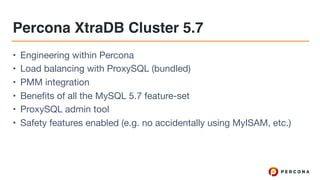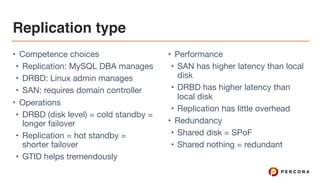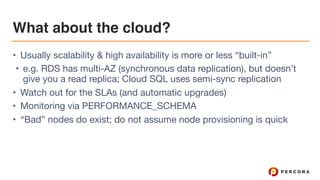OSDC 2018 | Scaling & High Availability MySQL learnings from the past decade+ by Colin Charles
- 1. Scaling & High Availability MySQL learnings from the past decade+ Colin Charles, Chief Evangelist, Percona Inc. [email protected] / [email protected] http://www.bytebot.net/blog/ | @bytebot on Twitter OSDC.de, Berlin, Germany 12 June 2018
- 2. whoami • Chief Evangelist, Percona Inc • Focusing on the MySQL ecosystem (MySQL, Percona Server, MariaDB Server), as well as the MongoDB ecosystem (Percona Server for MongoDB) + 100% open source tools from Percona like Percona Monitoring & Management, Percona xtrabackup, Percona Toolkit, etc. • Founding team of MariaDB Server (2009-2016), previously at Monty Program Ab, merged with SkySQL Ab, now MariaDB Corporation • Formerly MySQL AB (exit: Sun Microsystems) • Past lives include The Fedora Project (FESCO), OpenOffice.org • MySQL Community Contributor of the Year Award winner 2014
- 3. License • Creative Commons BY-NC-SA 4.0 • https://creativecommons.org/licenses/by-nc-sa/4.0/legalcode
- 7. Uptime Percentile target Max downtime per year 90% 36 days 99% 3.65 days 99.5% 1.83 days 99.9% 8.76 hours 99.99% 52.56 minutes 99.999% 5.25 minutes 99.9999% 31.5 seconds
- 8. Estimates of levels of availability Method Level of Availability Simple replication 98-99.9% Master-Master/MMM 99% SAN 99.5-99.9% DRBD, MHA 99.9% NDBCluster, Galera Cluster, InnoDB Cluster 99.999%
- 9. HA is Redundancy • RAID: disk crashes? Another works • Clustering: server crashes? Another works • Power: fuse blows? Redundant power supplies • Network: Switch/NIC crashes? 2nd network route • Geographical: Datacenter offline/destroyed? Computation to another DC
- 10. Durability • Data stored on disks • Is it really written to the disk? ▪ being durable means calling fsync() on each commit • Is it written in a transactional way to guarantee atomicity, crash safety, integrity?
- 11. High Availability for databases • HA is harder for databases • Hardware resources and data need to be redundant • Remember, this isn’t just data - constantly changing data • HA means the operation can continue uninterrupted, not by restoring a new/backup server • uninterrupted: measured in percentiles
- 12. Redundancy through client-side XA transactions • Client writes to 2 independent but identical databases • HA-JDBC (http://ha-jdbc.github.io/) • No replication anywhere
- 13. InnoDB “recovery” time • innodb_log_file_size • larger = longer recovery times • In 2007, Wikipedia reported 40 minutes with 256MB logs; sometimes it takes 5-10 minutes, sometimes hours • Percona Server 5.5 (XtraDB) - innodb_recovery_stats • But today, there has been paradigm change…
- 14. Redundancy through shared storage • Requires specialist hardware, like a SAN • Complex to operate • One set of data is your single point of failure • Cold standby • failover 1-30 minutes • this isn’t scale-out • Active/Active solutions: Oracle RAC
- 15. Redundancy through disk replication • DRBD • Linux administration vs. DBA skills • Synchronous • Second set of data inaccessible for use • Passive server acting as hot standby • Failover: 1-30 minutes • Performance hit compared to single node performance, with higher average latencies
- 16. Redundancy through MySQL replication • MySQL replication • Tungsten Replicator • Galera Cluster • MySQL InnoDB Cluster • MySQL Cluster (NDBCLUSTER) • Storage requirements are multiplied • Huge potential for scaling out
- 17. MySQL Replication • Statement based generally • Row based became available in 5.1, and the default in 5.7 • mixed-mode, resulting in STATEMENT except if calling ▪ UUID function, UDF, CURRENT_USER/USER function, LOAD_FILE function ▪ 2 or more AUTO_INCREMENT columns updated with same statement ▪ server variable used in statement ▪ storage engine doesn’t allow statement based replication, like NDBCLUSTER ▪ default in MariaDB Server 10.2
- 18. MySQL Replication II • Asynchronous by default • Semi-synchronous plugin in 5.5+ • However the holy grail of fully synchronous replication is not part of standard MySQL replication (yet?) • MariaDB Galera Cluster is built-in to MariaDB Server 10.1 • MySQL InnoDB Cluster is available in MySQL 8.0, combining the likes of group replication (the Galera Cluster equivalent), InnoDB, and mysqlsh for maintaining it; it also uses MySQL Router for load balancing purposes
- 19. Semi-synchronous replication • semi-sync capable slave acknowledges transaction event only after written to relay log & flushed to disk • timeout occurs? master reverts to async replication; resumes when slaves catch up • at scale, Facebook runs semi-sync: http:// yoshinorimatsunobu.blogspot.com/2014/04/semi-synchronous- replication-at-facebook.html
- 20. MySQL Replication in 5.6 • Global Transaction ID (GTID) • Server UUID • Ignore (master) server IDs (filtering) • Per-schema multi-threaded slave • Group commit in the binary log • Binary log (binlog) checksums • Crash safe binlog and relay logs • Time delayed replication • Parallel replication (per database)
- 21. Replication: START TRANSACTION WITH CONSISTENT SNAPSHOT • Works with the binlog, possible to obtain the binlog position corresponding to a transactional snapshot of the database without blocking any other queries. • by-product of group commit in the binlog to view commit ordering • Used by the command mysqldump--single-transaction --master- data to do a fully non-blocking backup • Works consistently between transactions involving more than one storage engine • https://kb.askmonty.org/en/enhancements-for-start-transaction-with- consistent/ • Percona Server improved it, by session ID, and also introducing backup locks
- 22. Multi-source replication • Multi-source replication - (real-time) analytics, shard provisioning, backups, etc. • @@default_master_connection contains current connection name (used if connection name is not given) • All master/slave commands take a connection name now (like CHANGE MASTER “connection_name”, SHOW SLAVE “connection_name” STATUS, etc.)
- 23. Global Transaction ID (GTID) • Supports multi-source replication • GTID can be enabled or disabled independently and online for masters or slaves • Slaves using GTID do not have to have binary logging enabled. • (MariaDB) Supports multiple replication domains (independent binlog streams) • Queries in different domains can be run in parallel on the slave.
- 24. Why MariaDB GTID is different compared to 5.6? • MySQL 5.6 GTID does not support multi-source replication (only 5.7 supports this) • Supports —log-slave-updates=0 for efficiency (like 5.7) • Enabled by default • Turn it on without having to restart the topology (just like 5.7)
- 25. Parallel replication • Multi-source replication from different masters executed in parallel • Queries from different domains are executed in parallel • Queries that are run in parallel on the master are run in parallel on the slave (based on group commit). • Transactions modifying the same table can be updated in parallel on the slave! • Supports both statement based and row based replication.
- 26. All in… sometimes it can get out of sync • Changed information on slave directly • Statement based replication • non-deterministic SQL (UPDATE/DELETE with LIMIT and without ORDER BY) • triggers & stored procedures • Master in MyISAM, slave in InnoDB (deadlocks) • --replication-ignore-db with fully qualified queries • Binlog corruption on master • PURGE BINARY LOGS issued and not enough files to update slave • read_buffer_size larger than max_allowed_packet • Bugs?
- 27. Replication Monitoring • Percona Toolkit is important • pt-slave-find: find slave information from master • pt-table-checksum: online replication consistency check • executes checksum queries on master • pt-table-sync: synchronise table data efficiently • changes data, so backups important
- 28. Replication Monitoring with PMM •http://pmmdemo.percona.com/
- 29. mysqlbinlog versions • ERROR: Error in Log_event::read_log_event(): 'Found invalid event in binary log', data_len: 56, event_type: 30 • 5.6 ships with a “streaming binlog backup server” - v.3.4; MariaDB 10 doesn’t - v.3.3 (fixed in 10.2 - MDEV-8713) • GTID variances! • Beware mysql-client from your Linux distribution
- 30. Slave prefetching • Replication Booster • https://github.com/yoshinorim/replication-booster-for-mysql • Prefetch MySQL relay logs to make the SQL thread faster • Tungsten has slave prefetch • Percona Server till 5.6 + MariaDB till 10.1 have InnoDB fake changes
- 31. Changing paradigm: What replaces slave prefetching? • In Percona Server 5.7, slave prefetching has been replaced by doing intra-schema parallel replication • Feature removed from XtraDB • MariaDB Server 10.2 also has this feature removed, as they switched to InnoDB!
- 32. Galera Cluster • Inside MySQL, a replication plugin (wsrep) • Replaces MySQL replication (but can work alongside it too) • True multi-master, active-active solution • Virtually Synchronous • WAN performance: 100-300ms/commit, works in parallel • No slave lag or integrity issues • Automatic node provisioning
- 34. Percona XtraDB Cluster 5.7 • Engineering within Percona • Load balancing with ProxySQL (bundled) • PMM integration • Benefits of all the MySQL 5.7 feature-set • ProxySQL admin tool • Safety features enabled (e.g. no accidentally using MyISAM, etc.)
- 35. Group replication • Fully synchronous replication (update everywhere), self-healing, with elasticity, redundancy • Single primary mode supported • MySQL InnoDB Cluster - a combination of group replication, Router, to make magic! • Recent blogs: • https://www.percona.com/blog/2017/02/24/battle-for-synchronous- replication-in-mysql-galera-vs-group-replication/ • https://www.percona.com/blog/2017/02/15/group-replication-shipped- early/
- 36. Summary of Replication Performance • SAN has "some" latency overhead compared to local disk. Can be great for throughput. • DRBD has a performance penalty • Replication, when implemented correctly, has no performance penalty • But MySQL replication with disk bound data set has single-threaded issues! • Semi-sync is poorer on WAN compared to async • Galera & InnoDB Cluster provide read/write scale-out, thus more performance
- 37. Handling failure • How do we find out about failure? • Polling, monitoring, alerts... • Error returned to and handled in client side • What should we do about it? • Direct requests to the spare nodes (or DCs) • How to protect data integrity? • Master-slave is unidirectional: Must ensure there is only one master at all times. • DRBD and SAN have cold-standby: Must mount disks and start mysqld. • In all cases must ensure that 2 disconnected replicas cannot both commit independently. (split brain)
- 38. Frameworks to handle failure • MySQL-MMM • Severalnines ClusterControl • Orchestrator • MySQL MHA • Percona Replication Manager • Tungsten Replicator • 5.6: mysqlfailover, mysqlrpladmin • (MariaDB) Replication Manager
- 39. Orchestrator • Reads replication topologies, keeps state, continuous polling • Modify your topology — move slaves around • Nice GUI, JSON API, CLI
- 40. MySQL MHA • Like MMM, specialized solution for MySQL replication • Developed by Yoshinori Matsunobu at DeNA • Automated and manual failover options • Topology: 1 master, many slaves • Choose new master by comparing slave binlog positions • Can be used in conjunction with other solutions • http://code.google.com/p/mysql-master-ha/
- 41. Pacemaker • Heartbeat, Corosync, Pacemaker • Resource Agents, Percona-PRM • Percona Replication Manager - cluster, geographical disaster recovery options • Pacemaker agent specialised on MySQL replication • https://github.com/percona/percona-pacemaker-agents/ • Pacemaker Resource Agents 3.9.3+ include Percona Replication Manager (PRM)
- 42. Load Balancers for multi-master clusters • Synchronous multi-master clusters like Galera require load balancers • HAProxy • Galera Load Balancer (GLB) • MaxScale • ProxySQL
- 43. MySQL Router • Routing between applications and any backend MySQL servers • Failover • Load Balancing • Pluggable architecture (connection routing)
- 44. MariaDB MaxScale • “Pluggable router” that offers connection & statement based load balancing • Possibilities are endless - use it for logging, writing to other databases (besides MySQL), preventing SQL injections via regex filtering, route via hints, query rewriting, have a binlog relay, etc.
- 45. ProxySQL • High Performance MySQL proxy with a GPL license • Performance is a priority - the numbers prove it • Can query rewrite • Sharding by host/schema or both, with rule engine + modification to SQL + application logic
- 46. JDBC/PHP drivers • JDBC - multi-host failover feature (just specify master/slave hosts in the properties) • true for MariaDB Java Connector too • PHP handles this too - mysqlnd_ms • Can handle read-write splitting, round robin or random host selection, and more
- 47. Clustering: solution or part of problem? • "Causes of Downtime in Production MySQL Servers" whitepaper, Baron Schwartz VividCortex • Human error • SAN • Clustering framework + SAN = more problems • Galera/group replication is replication based, has no false positives as there’s no “failover” moment, you don’t need a clustering framework (JDBC or PHP can load balance), and is relatively elegant overall
- 48. Replication type • Competence choices • Replication: MySQL DBA manages • DRBD: Linux admin manages • SAN: requires domain controller • Operations • DRBD (disk level) = cold standby = longer failover • Replication = hot standby = shorter failover • GTID helps tremendously • Performance • SAN has higher latency than local disk • DRBD has higher latency than local disk • Replication has little overhead • Redundancy • Shared disk = SPoF • Shared nothing = redundant
- 49. SBR vs RBR? Async vs sync? • row based: deterministic • statement based: dangerous • GTID: easier setup & failover of complex topologies • async: data loss in failover • sync: best • multi-threaded slaves: scalability (hello 5.6+, Tungsten)
- 50. What about the cloud? • Usually scalability & high availability is more or less “built-in” • e.g. RDS has multi-AZ (synchronous data replication), but doesn’t give you a read replica; Cloud SQL uses semi-sync replication • Watch out for the SLAs (and automatic upgrades) • Monitoring via PERFORMANCE_SCHEMA • “Bad” nodes do exist; do not assume node provisioning is quick
- 51. Conclusion • MySQL replication is amazing if you know it (and monitor it) well enough • Large sites run just fine with semi-sync + tooling for automated failover • Galera Cluster/MySQL InnoDB Cluster is great for virtually fully synchronous replication • Don’t forget the need for a load balancer: ProxySQL is nifty • When thinking scaling, think scale out (it is more efficient, and fits modern cloud mantras too!)
- 52. At Percona, we care about your High Availability • Percona XtraDB Cluster 5.7 with support for ProxySQL and Percona Monitoring & Management (PMM) • Percona Monitoring & Management (PMM) with Orchestrator • Percona Toolkit • Percona Server for MySQL 5.7 • Percona XtraBackup
- 53. Thank you! Colin Charles [email protected] / [email protected] http://bytebot.net/blog | @bytebot on twitter slides: slideshare.net/bytebot





















































